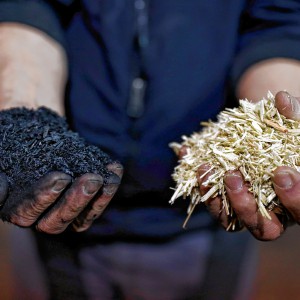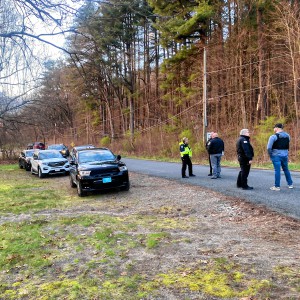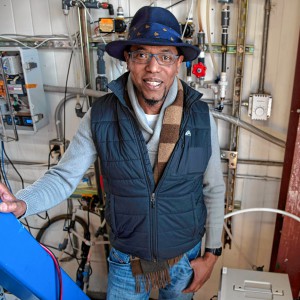Speaking of Nature: Man vs. squirrel, round 2
| Published: 02-17-2023 8:29 PM |
In last week’s column, I featured the American red squirrel and I shared a photo of one of these rascals solving the puzzle of one of my birdfeeders. “How, do I get those peanuts?” it must have wondered and in relatively short order it managed to get in. By the end of the day there were no peanuts left in that particular feeder, but an identical feeder hanging just two feet away remained full. So, with a little human brainpower brought to bear on the issue, I was able to repair a little damage and once again render the feeder squirrel-proof.
This week I am featuring the “other” squirrel – the eastern gray squirrel. My personal disposition toward this squirrel is much different than that I hold for its smaller cousin. As a person who feeds birds, the gray squirrel is my natural enemy; a parasite that cleans out my seed supply (quite expensive seed ever since COVID hit) and offers nothing in return. Two or three gray squirrels can completely dominate a feeding station and prevent dozens of birds from getting anything to eat. How many of my readers are nodding their heads in agreement right now? How many are even starting to twitch and spasm with apoplectic rage? I’ll give you a moment to regain your composure. Okay, let’s continue.
It was this infuriating conflict between me and a bunch of rodents that basically ignore me and do whatever they want that finally drove me to spend some money in an attempt to exact some sort of revenge upon them. I went to my local seed supplier, took a slow walk through the birdfeeder section and finally selected a feeder that I thought would do the trick. I can’t offer any product names, but a look at the photo should suffice for the general design.
This feeder is made of relatively heavy steel sheet metal that has been painted a cheerful red. Other models I have seen are painted a pine green. The magic behind the feeder is its pressure-sensitive perches. Adjustable springs determine the weight that the perches will tolerate and small birds, like chickadees and goldfinches, can land on the feeder and take seeds from the recessed seed trough.
However, a larger animal (like a squirrel) will cause the perches to move downward and cover the recessed seed troughs with some of that wonderful steel sheet metal. Birds can eat, but squirrels can’t. Muahaha!
The first day that I deployed the feeder I didn’t see any squirrel pay any attention to it at all. This is obviously due to the fact that I was home and I never let the seed supply run dry, which meant that this feeder was not the only game in town. However, on the first work day, when I had to leave home, I returned in the late afternoon to discover that the springs that govern the sensitivity of the perches had been meddled with. Aha! Evidence of squirrel rage! A feeling of pure joy soaked into my body. It had worked.
But I wanted more! I couldn’t stand just knowing that it worked, I wanted to actually see the feeder exclude the squirrels. I wanted to see their frustration grow and their increasingly desperate maneuvers fail again and again. So, determined to be rewarded for my efforts, I set up shop at the kitchen window to see how things played out on a Saturday morning.
The start of the morning was all pretty standard. First the white-throated sparrows, juncos and cardinals showed up. Then some mourning doves and blue jays arrived. Chickadees, nuthatches and downy woodpeckers rounded out the morning crowd until the squirrels finally arrived. They immediately claimed the seed for themselves, pushing the birds to the periphery where they could only hope for scraps. A squirrel claimed my platform feeder and emptied it. Another squirrel claimed my covered platform feeder and emptied it. The only thing that made this morning different was the fact that I didn’t make any effort to replenish the seed supply. That’s when things got interesting.
Article continues after...
Yesterday's Most Read Articles
 Locking up carbon for good: Easthampton inventor’s CO2 removal system turns biomass into biochar
Locking up carbon for good: Easthampton inventor’s CO2 removal system turns biomass into biochar
 Northampton man will go to trial on first-degree murder charge after plea agreement talks break down
Northampton man will go to trial on first-degree murder charge after plea agreement talks break down
 Police report details grisly crime scene in Greenfield
Police report details grisly crime scene in Greenfield
 Area property deed transfers, April 25
Area property deed transfers, April 25
 Advancing water treatment: UMass startup Elateq Inc. wins state grant to deploy new technology
Advancing water treatment: UMass startup Elateq Inc. wins state grant to deploy new technology
 Super defers Amherst middle school principal pick to successor; one finalist says decision is retaliation for lawsuit
Super defers Amherst middle school principal pick to successor; one finalist says decision is retaliation for lawsuit
Eventually, the red metal feeder was the only one that was still full of seeds and the squirrels finally turned their attention to it. For one individual, an exploratory sniff brought the seed just an inch away, but when it reached out to get the food the perch lowered and blocked access. I was actually giggling as I took photos. Then the squirrel tried to bite the metal and instantly gave up; way too thick to even scratch. The springs got some attention, but again no luck. Finally, the squirrel hurled itself at the feeder and in doing so only managed to activate the perches and block the supply. No amount of tenacity or effort made any difference. The feeder (and the one who installed the feeder) won.
For the rest of the day the feeder supplied food to tufted titmice, black-capped chickadees, red-breasted and white-breasted nuthatches, American goldfinches and downy woodpeckers, but not a single seed went to a squirrel. Seed put on the ground was still being vacuumed up, but at least some of the smaller birds had access to food. I slept well that night, like I used to in the innocence of my youth. I was filled with a warm glow that suggested all was right in the world. If you would like to feel this warm contentment brought on by righting a wrong, just send me an email and I will be happy to reveal the make and model of the feeder that has brought me such joy.
Bill Danielson has been a professional writer and nature photographer for 25 years. He has worked for the National Park Service, the US Forest Service, the Nature Conservancy and the Massachusetts State Parks and he currently teaches high school biology and physics. For more in formation visit his website at www.speakingofnature.com, or head over to Speaking of Nature on Facebook.
]]>

 Valley Bounty: Grass-fed animals that feed the grass: Gwydyr Farm in Southampton focuses on ‘restoring the connection between land, food and people’
Valley Bounty: Grass-fed animals that feed the grass: Gwydyr Farm in Southampton focuses on ‘restoring the connection between land, food and people’ Weekly Food Photo Contest: This week’s winner: Mary Chicoine of Easthampton
Weekly Food Photo Contest: This week’s winner: Mary Chicoine of Easthampton  Speaking of Nature: A romantic evening for two birders — To hear the wonderful sounds of the Saw-whet Owl one must go outside at night
Speaking of Nature: A romantic evening for two birders — To hear the wonderful sounds of the Saw-whet Owl one must go outside at night Speaking of Nature: Where have all the birds gone?: They’re there, and here’s a handy tool to keep track of their appearances
Speaking of Nature: Where have all the birds gone?: They’re there, and here’s a handy tool to keep track of their appearances
